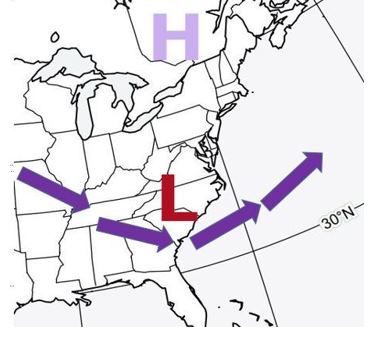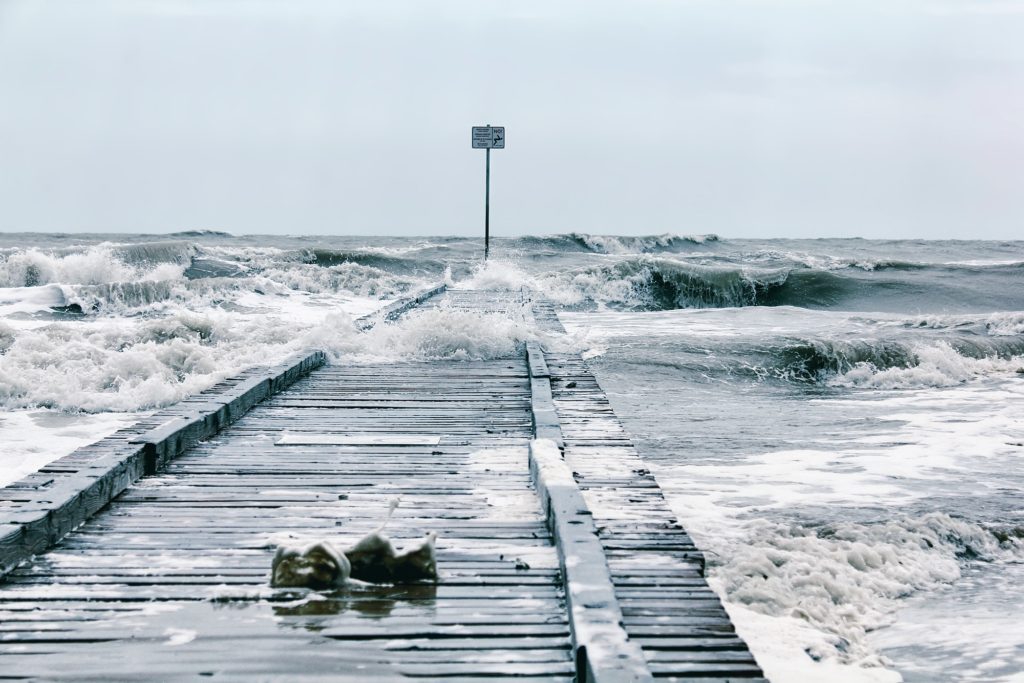Ash Wednesday of 2024 has just passed but if we go back sixty two years, one of the most notorious and destructive coastal storms on record ravaged the Middle Atlantic. The “Ash Wednesday” Storm as it came to be known, stalled along the U.S. East Coast. The storm was ranked among the top ten most destructive of the 20th century by NOAA. It literally chewed up the coastline from North Carolina to the south shore of Long Island and it dumped heavy snow inland. In all, the storm claimed 40 lives, over 1,250 were injured and the total damage was estimated at 200 million (1962) dollars, which would be over two billion dollars in 2024.
An image from the Front Page Of the Plainfield (NJ) Currier News on March 7, 1962. Image Credit-newspaperarchive.com.
Although the “Ash Wednesday” Storm produced most of its damage from North Carolina to Long Island, areas to the north and the south of the storm felt its effects. The storm first affected the Southeast on March 5th, 1962. Light snow fell in northeast Alabama.
Daytona, Beach, Florida reported winds of 42 mph, Tides were two feet above average at Vero Beach, Florida. High waves battered coastal areas and beachfront property damage in northern Florida reached 1 million (1962) dollars which would be a little over 10 million (2024 dollars) !
To the north, a few days later, high waves blasted coastal areas of southern New England and Block Island reported a wind gust to 84 mph. High waves flooded coastal areas all the way up to Maine. Very little precipitation made it up to New England with the storm, however.
The storm system stalled off the coast of North Carolina and Virginia on Tuesday, March 6th, and its devastating effects continued through Tuesday, March 8th. High waves and heavy rain were relentless.
The storm lasted through FIVE high tide cycles. To make matters worse, the moon was near Perigee (its closest point to the Earth during that time). It was also “Perigean spring tide” where the moon was in alignment with the sun and the earth. Plus, it was also the time around the “new moon”.
The relentless east to northeast wind flow across the surface of the Atlantic Ocean, along with the astronomical conditions, made the high tide even greater. Since this beast of a storm mainly affected the Mid-Atlantic region, we will start with North Carolina and work our way northward.
North Carolina
Relentless high waves pounded the east side of the Outer Banks and they obliterated sand dunes. A new inlet was created by the storm on Hatteras Island. Much of Highway 12 was washed away or buried in the sand. Whole cars were covered in sand. Inland, accumulating snow fell around Greensboro and northward into Virginia.
An image showing a bulldozer trying to repair beach damage at Nags Head, North Carolina from the “Ash Wednesday” Storm in March of 1962. Image Credit-YouTube.
Virginia
In Norfolk, one high tide reached 8.2 feet which is their third-highest on record. thousands of cars and homes were ooded in the Tidewater area. Hampton Roads reported a wind gust of 65 mph and a gust to 80 mph was reported around the lower Chesapeake Bay. Streets, roads, and highways suffered massive ooding and it was nearly impossible to get around.
At the time, construction of the Chesapeake Bay Bridge was underway but that work was delayed when wind gusts produced waves up to 50 feet which destroyed the world’s largest pile driver that stood on four 100 foot legs.
The pile driver became buried in sand and two workers had to be rescued by helicopter. Thousands of residents along the coast had to be rescued during this unrelenting storm.
Boats and homes were destroyed in Chincoteague Island and several “Chincoteague ponies” were killed. Monetary damage in Virginia reached 30 million (1962) dollars which would be 256 million dollars in 2024. At Wallops Island, one million dollars damage was done to the NASA Flight Facility.
The photo shows a man navigating by boast on a flooded street on Chincoteague Island, Virginia, after the “Ash Wednesday Storm in 1962. Photo Creditpinterest.com/David Parker.
Inland, heavy snow buried the Blue Ridge Mountains and the Shenandoah Valley areas. One reporting station in the Blue Ridge Mountains measured 42 inches of snow. The Harrisonburg, Virginia, area saw 27 inches and Winchester picked up 23 inches which was a record snowfall at the time.
A photo of a helicopter that brought supplies to isolated residents of the Harrisonburg, Virginia, area during the “Ash Wednesday” Storm in March of 1962. Photo Credit-Heritage Museum.
Many residents of those areas were stranded and travel came to a halt, The U.S. Army had to fly helicopters into some locations to deliver much-needed supplies to anxious residents.
Maryland
The damage to the coastline was described by many as incredible! High tides were estimated to be up to 6 feet above average. Sand dunes and beaches were washed away. Flooding closed roads and washed away many beach homes. Heavy rain produced flooding and power was lost over a large area. Inland, 1.2 million chickens and eggs were lost because of the storm.
Maryland Governor Millard Tawes declared the event the “worst disaster in my time in the state of Maryland.” The governor had surveyed the massive amount of damage to Ocean City by helicopter.
A photo showing inspectors surveying extreme damage to a house In Ocean City Maryland after the “Ash Wednesday” Storm in 1962. Photo Credit-Baltimore City Life Museum.
As the storm approached, the U.S. Weather Bureau had alerted the public that a nor’easter was coming but the residents had no inkling that the powerful and relentless storm would last for three days. Forecasting tools that are used by meteorologists today weren’t available back then. On Ash Wednesday (March 7th) the high tides were just under 10 feet below low tide.
There were three fatalities in Maryland from the storm.
Delaware
At The Delaware Breakwater, one high tide reached 9.3 feet above average before the gage failed but it was estimated to be an incredible 11 feet above average. Rehoboth Beach saw waves up to 40 feet high. Saltwater penetrated well inland and it destroyed many agricultural fields. There were seven fatalities in the state.
A photo showing inspectors surveying extreme damage to a house In Ocean City Maryland after the “Ash Wednesday” Storm in 1962. Photo Credit-Baltimore City Life Museum.
New Jersey
Coastal residents of New Jersey were given little or no warning that a storm of his magnitude, intensity or duration was on the way. Meteorologists had no idea that the storm would stall and end up as a three-day event.
Extremely high waves batted the New Jersey coast for five high tide periods. Wind gusts were flirting with hurricane-force with Long Branch reporting a gust to 73 mph. The highest tide was recorded at Harrison with 7.7 feet.
Beaches and homes and other structures along the coast were severely damaged or washed away.
Some homes that were knocked off of their foundations were found up to a mile inland. In all, 4,000 homes were completely destroyed and another 40,000 were severely damaged by water.
Floodwaters breached Long Beach Island at five locations.
This image shows the damage inflicted by the “Ash Wednesday” Storm in March of 1962 at Cape May, New Jersey. Image Credit- YouTube.
In Atlantic City, a quarter-mile section of the Steel Pier washed away. One high tide at Atlantic City was about 10 feet above average. Thousands of stranded residents attempted to escape coastal areas by boat but they were stopped by icy waters. The US. Army sent in helicopters to evacuate many residents.
In many coastal towns, boardwalks were destroyed, rail lines were compromised and electricity was cut off. Homes that did withstand the storm were without heat and sewage facilities. Downed power lines sparked numerous fires that continued to burn because re stations couldn’t get their trucks into those areas.
The photo shows extensive damage at Atlantic City, New Jersey, from the “Ash Wednesday” Storm in March of 1962.Photo Credit – Atlantic City Free Public Library.
The death toll in New Jersey was 14 and another dozen went missing and were presumed dead. In Avalon, New Jersey, six entire blocks were destroyed.
Farther north, 100 homes were destroyed on the south shore of Long Island with high tides over 8.5 feet above average.
In the Atlantic, the storm split a 500-foot Liberian tanker in half. Three Navy destroyers had to be sent to rescue 27 men that were left stranded. In addition, fifteen men were lost at sea on fishing trawlers.
Meteorological Conditions
On March 4th low pressure developed off the Southeast Coast of the U.S. A deep trough of pressure aloft was around the Ohio Valley moving southeastward. In the upper atmosphere, a high-pressure ridge was building over Canada south of James Bay.
The upper-level trough slid southeastward helped the coastal low to intensify on March 6th. The low’s central pressure dipped to 979 millibars (28.90 inches of mercury) . An upper-level trough closed off around the Carolinas south of the high-pressure aloft. Meteorologists call this a “Rex Block”.
The map above shows the upper-level 500 millibar pattern “Rex Block” on March 7, 1962, which caused the “Ash Wednesday” Storm to stall.
The surface low responded by stalling and wandering around off the coast of the Carolinas. Also, at the surface, high pressure built into Quebec. The strong pressure gradient between the low and the high created the strong winds.
Surface weather map for March 7, 1962. Note the number of isobars north of the low indicating a strong pressure gradient. Map Credit-U.S. Weather Bureau.
The stalling low-pressure system kept a persistent east to northeast wind over the Mid-Atlantic region and high waves continued to batter the East Coast for three days. The astronomical condition that I mentioned earlier produced extremely high tides for 5 tide cycles.
Many nor’easters produce coastal damage and most of them move along but this one certainly didn’t. Heavy rain fell around the coast but there was heavy snow well inland.
According to the U.S. Geological Survey, the “Ash Wednesday” Storm was probably the largest East Coast winter storm in terms of coastal damage and the number of homes damaged or destroyed.
This storm has been long remembered by the who were there to experience its furious wrath.












